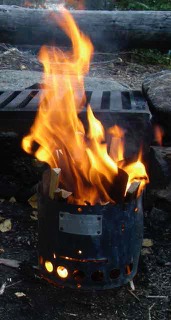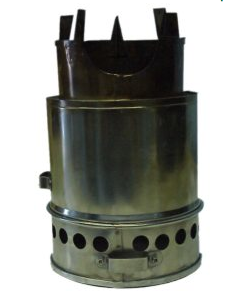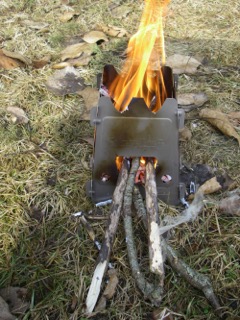Most of today’s self-propelled campers rely on liquid-fueled (propane, butane, gasoline, alcohol) stoves for all their cooking. But there’s a hardcore minority who prefer the lightweight and reliability of wood. Admittedly, I haven’t always been a big fan of wood-burning trail stoves. That said, I almost always bring one on my canoeing and camping trips. It keeps the kettle boiling, saves liquid fuel and provides heat and ambience when I don’t have a campfire. And it’s useful for burning trash—important on a long trip where packing garbage can attract animals.
In my opinion, the three trail stoves reviewed here represent the best of the breed. All are efficient, lightweight, sturdy, compact and beautifully made. What’s best for you depends on the style in which you travel—how light you want to go and whether you plan to use a liquid-fueled stove for some of your cooking. As a bonus, all of these stoves can be fueled with alcohol, heat tabs or Sterno.
Advantages of wood-burning stoves over models that burn liquid fuel include:
- No fuel to buy or carry
- Usually lighter and more compact than liquid-fuel models, and takes less space in a pack
- Gives off warming heat and can double as a small campfire
The disadvantages are:
- You must collect the wood it burns. Collecting wood can be illegal.
- In many places, they are not a legal substitute for a liquid-fuel stove. They are never legal anywhere during a fire-ban.
- Most won’t accept sizeable logs, especially with a pot on top. You must constantly feed the beast.
- Blackens pots, which can result in soiled gear and hands.
CONSIDERATIONS
- WEIGHT: Generally, the lighter the better—the stove must be sturdy enough to support a heavy pot.
- HEIGHT VS. DIAMETER: Height increases the chimney effect and burning efficiency. But a too high stove can be tippy. A wide opening will accept thicker sticks than a narrow opening. Stoves that accept only small sticks require constant feeding.
- BASE (floor): A base keeps hot coals from burning the ground. A separate (removable) base is more versatile than an integral one. Why? Because with use, the building ash clogs the vent holes and reduces the air flow. Eventually, the stove shuts down. You may have to extinguish the stove and invert it to clear the ashes. If the base is separate (mini-fire pan) you can lift the stove and shake out the ash from the bottom.
- SPEED OF ASSEMBLY: All the stoves reviewed here are fast and easy to assemble. The Trek Stov leads the pack at just five seconds.
- STABILITY: All these stoves will support heavy pots. Very wide kettles and heavy sticks that are much longer than the stove is high, adversely affect stability.
STOVES:
LITTLBUG Sr. and Jr.
The Littlbug Senior and Junior are identical except for size (see table below). The stoves are ingeniously simple—just snap two stainless steel halves together. The stove’s near zero thickness takes up almost no space at all in a pack; the rounded half-shape nests tightly against a rolled sleeping pad or the inside wall of a barrel. The stove can be used with or without its pot supports. Without them, it will accept logs nearly as large as its diameter. With them and a pot on top, the openings are smaller—2.5 or 4.0 inches, depending on the model. Long logs can be stacked “inverted tipi” style around the pot, creating quite a blaze—and enough heat to double as a roaring campfire.
The pot supports can be lowered to fire the stove with alcohol or Sterno. The unit can be used as a windscreen for a commercial alcohol burner or a liquid fuel stove. An ultralight (optional) folding “Fire-bowl” base contains ashes and makes dumping them a breeze—or just use a pizza pan. If you’re camping on snow, the stove can be suspended from a branch with the lightweight chain set provided. Sounds goofy but it works great even with heavy pots. I seldom go on a trip without a Littlbug stove. www.littlbug.com.
 TREK STOV
TREK STOV
The Trek Stove has three parts: the lid, which provides ventilation and doubles as a fire pan, the double-wall stove body, and the pot support ring. Assembly is almost instantaneous. The double-walled stove body has small vent holes around the inside top. There are larger holes at the bottom. The two sets of vent holes and double-wall construction permit fast starts and very clean burning. Wood seems to burn hotter, more slowly and more efficiently in this stove than in the others in our sample. A wide U-shaped opening in the pot support ring allows entry of fairly thick sticks. The stove will accept wood up to about two inches in diameter if there’s no pot on top. Add a pot and you must halve the diameter of the fuel. There’s an ash screen at the bottom. Ashes fall into the base (which becomes the cover when the stove is packed).
Lift the stove off the base to dump the ashes (requires some effort if the stove is hot and choked with ash). There’s a 1.5 inch diameter hole in the center of the base: The battery operated fan of a Sierra Zip stove can be inserted into that hole. The fan turns the Trek Stov into a veritable blow torch! The Trek Stove is remarkably engineered and a work of art. It is the most sturdy, easiest to assemble and most sophisticated stove in our sample. It is also the heaviest and bulkiest. Unlike the other stoves here, it won’t blacken your hands when you take it apart to pack it away. http://www.nimbuskayaks.com/Trek%20stove.htm.
EMBERLIT STOVE
Constructed from ultralight titanium or stainless steel, the EmberLIt is the most compact stove in our sample. Five “playing card thin” pieces—four sides and a base—snap together with ease and precision. With practice, assembly takes only about 30 seconds. When packed, this tiny stove consumes about as much space as a large post card. The little stove is remarkably strong for its weight–it easily supported my 20 pound Dutch oven! You must insert two titanium cross-bars provided (it takes just seconds) when using pots that are smaller than the stove top. The cross bars are used only to support small pots—they are not needed for rigidity.
The Emberlit will accept wood up to about 1.5 inches in diameter with a pot on top or 3.5 inches without a pot. You can fuel it from the top or through a port in the side (near the base). This is the only stove in our sample that can be fueled and lit from the side. The others must be lit from the top or through a vent hole near the bottom, which can be awkward. The EmberLIt develops a fast efficient draft, but wood burns quickly—you must keep feeding it. Though fairly thick sticks can be loaded through the top of the stove, they must be short—ones that are too long will unbalance and topple the stove. Very long sticks may be loaded through the side port but you must “keep “pushing” them forward as they burn. The EmberLit shines best for preparing quick meals where its run time is short. It’s not designed to double as a campfire. www.emberlit.com.
CLIFF’S RECOMMENDATIONS
- For going ultralight, preparing fast meals, and where bulk and weight are prime concerns, I recommend the Littlbug Jr. and EmberLit Stove
- For long burning times and stability with large wood, plus puts out enough heat to double as a campfire, I recommend the Littlbug Senior.
- For maximum fuel efficiency and instant assembly, go with the Trek Stov.
SPECS COMPARED
| LITTLBUG JR. | LITTLBUG SR. | TREK STOV | EmberLit STOVE | |
| Weight (oz) | 5.0 | 19 | 24 | 5.5 titanium / 11.3 SS |
| Packed size (inches) | 7.0 x 5.0 x 1/16 | 11 x 7 x 1/16 | 4.5 x.4.5 x 6.0 | 6.0 x 5.0 x 1/16 |
| Assembled size/inches | 5.4 x 6.3 | 8.0” x 9.0” | 8.25 x 5.1 x 8.4 | 6.0 x 5.0 x 5.0 |
|
Largest opening (inches): suggests size of largest diameter wood it will accept. |
2.5 with pot on top or 6.0 without pot |
4.0 with pot or 8.0 without /pot |
2.5 with pot 4.1 without pot |
1.5 with pot 3.5 without pot. |
|
Base: |
Optional folding “Fire-bowl” 3.8 oz |
Optional folding “Fire-bowl” 7.4 oz |
Removable | Integral |
| Constructed from | Stainless steel | Stainless steel | Stainless steel | Titanium/stainless steel |
| Ease/speed of Assembly/disassembly | 20 seconds | 20 seconds | 5 seconds | 30 seconds |
|
Stability with a wide, heavy pot on top: 1= Solid, like a rock! 2 =Very stable 3 =Acceptably stable |
3 | 3 | 1 |
2 |
| Fit, finish and quality of construction | Excellent | Excellent | Excellent | Excellent |
| Carrying case provided | Yes | Yes | No | Yes |
Cliff Jacobson is a wilderness canoeing and camping consultant and the author of over a dozen top-selling books on camping and canoeing. His video, The Forgotten Skills, details the most important campcraft procedures. He is a Distinguished Eagle Scout and a recipient of the American Canoe Association’s Legends of Paddling award. http://cliff-jacobson.com.




 TREK STOV
TREK STOV
